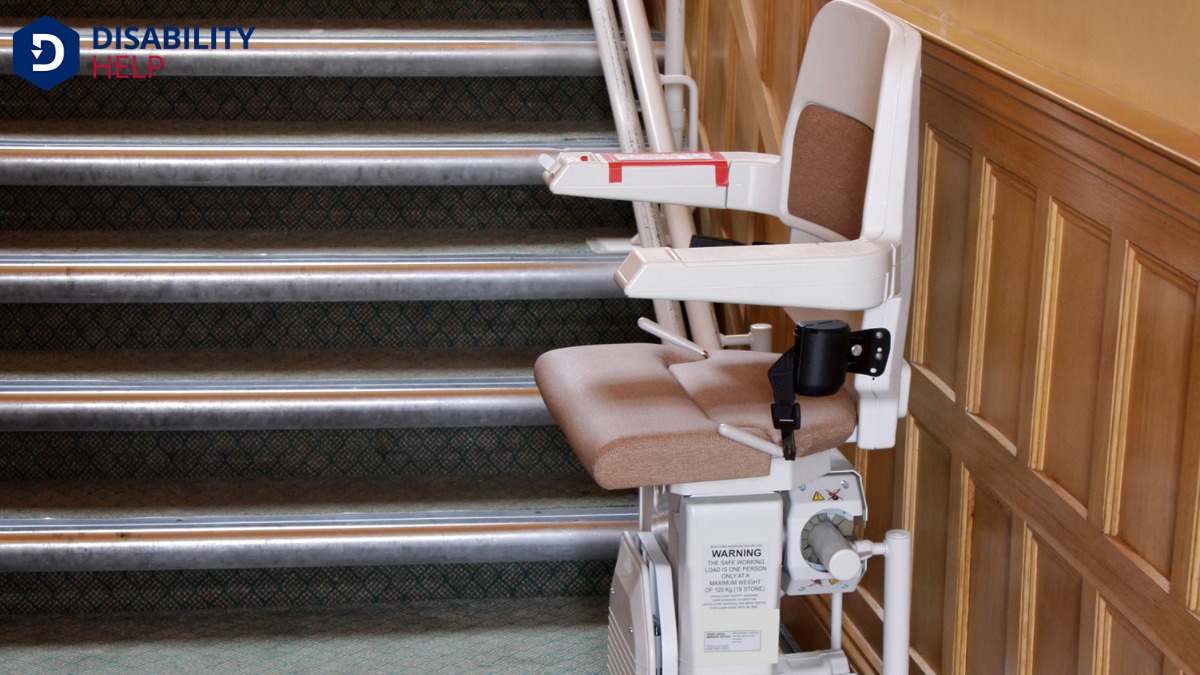When discussing stair lifts and stair climbers, we often find ourselves questioning which option best suits our needs. These devices, though seemingly similar, serve distinct purposes and cater to different mobility requirements. While stair lifts provide a seated, stable ride along a fixed rail, stair climbers offer a more flexible, portable solution. But what other factors should we consider when choosing between them? Let’s explore further to uncover these differences.
Key Takeaways
- Stair lifts provide seated transportation along a rail, while stair climbers assist walking with a dynamic step interaction.
- Stair lifts require permanent installation, whereas stair climbers are portable and do not need fixtures.
- Stair lifts are used for stability and ease, while stair climbers offer more flexibility for users with some walking ability.
- Stair lifts typically have higher initial and maintenance costs compared to stair climbers.
- Stair climbers are compact and suitable for temporary use, unlike the more space-consuming stair lifts.
Understanding Stair Lifts
When we start exploring the concept of stair lifts, it's important to recognize their primary purpose: providing safe and efficient mobility for individuals with limited accessibilityThe design of products, devices, services, or environments to be usable by people with disabilities.... on stairs.
Stair lifts are mechanical devices that transport people up and down stairs while seated, offering an essential solution for those who find stair navigation challenging. They consist of a chair or platform attached to a rail, installed along the staircase, guaranteeing a smooth ride.
We often see them in homes where residents need assistance due to age, injury, or disability. They’re user-friendly, with controls allowing easy operation.
Understanding Stair Climbers
While stair lifts offer a seated ride, stair climbers provide a different approach to overcoming stairway challenges. Instead of a stationary seat, stair climbers involve a more dynamic interaction with the steps. We might think of them as mobile devices or aids that help us ascend or descend stairs by physically supporting our movement. They’re designed to accommodate those who can still walk but need extra assistance due to mobility issues.
Stair climbers can be manual or powered, and they’re typically compact and portable. This makes them suitable for different staircases without requiring permanent installation.
We can easily store them away when not in use. By understanding these devices, we can gain more insight into how stair climbers enhance mobility and independence at home.
Mechanisms and Operation

To fully appreciate stair climbers, we need to explore their mechanisms and operation.
Stair climbers are designed to assist us in ascending and descending stairs safely. They use a combination of motorized tracks or wheels that grip the stairs securely, allowing smooth movement over each step.
We control the stair climber through a simple interface, often featuring buttons or a joystick, making it user-friendly.
The device's sensors guarantee stability and safety during operation by adjusting speed and braking as necessary.
A key component is the battery, which powers the climber and is typically rechargeable.
This means it's crucial to keep the device charged for reliable use.
Understanding these elements helps us realize how stair climbers provide an effective mobility solution.
Installation and Space Requirements
Let's explore how stair lifts and stair climbers differ in their installation process and the space they need.
We'll consider the necessary structural modifications and the impact they've on our homes.
Understanding these differences helps us make informed decisions on which option suits our needs best.
Installation Process Differences
When considering the installation of a stair lift versus a stair climber, understanding the differences in space requirements and installation processes is crucial.
Stair lifts generally require a more complex installation process. They need to be securely mounted to the stairs, often necessitating professional installation to guarantee safety and reliability.
We'll typically see stair lifts involving rail systems customized to the specific staircase, which might involve drilling and anchoring.
On the other hand, stair climbers are usually more straightforward. They’re portable devices that don’t require permanent fixtures or modifications to the stairs.
This makes them easier to set up and remove, offering flexibility. However, stair climbers may require a temporary ramp or additional support to guarantee safe operation, depending on the model used.
Space Considerations Needed
While evaluating space considerations for stair lifts and stair climbers, we must account for both installation requirements and the physical space each option occupies.
Stair lifts typically require more space, as they run along a track attached to the staircase. We’ll need to confirm there's enough room for the track and the seat when it's folded.
Stair climbers, on the other hand, don’t require permanent fixtures. They're portable and used only when needed, which means they take up space when in use but can be stored elsewhere.
As we assess our options, let's consider the width of the staircase and how often the device will be in operation. It’s essential to balance convenience and available space to make the right choice.
Structural Modifications Required
Considering the space needs of stair lifts and stair climbers naturally leads us to examine the structural modifications required for each option.
Stair lifts usually need a rail system installed along the staircase. This can involve drilling into the stairs or walls and might require professional installation. We should verify the staircase can support the added structure, focusing on the integrity of the walls and steps.
In contrast, stair climbers are portable devices that don't require permanent alterations. They work on existing staircases without needing rails. However, we must confirm there's enough space at the top and bottom of the stairs for ease of use.
While stair climbers offer flexibility, stair lifts provide a more permanent solution, each catering to different needs and preferences.
User Experience and Comfort
As we explore the user experience and comfort of stair lifts and stair climbers, it's clear both devices aim to enhance mobility, but they do so in different ways.
Stair lifts provide a seated experience, which can be more comfortable for those who prefer stability during transit. The chair moves smoothly along a rail, allowing us to sit back and relax.
In contrast, stair climbers require users to stand or lean while the device assists in moving up the stairs. This might feel less stable but offers a sense of agencyThe capacity of individuals with disabilities to act independently and make their own choices. and control.
Both devices are designed with safety features like seat belts or handles, ensuring security during use.
Ultimately, our choice hinges on personal preference and how we prioritize comfort and control.
Suitability for Different Mobility Needs

Let's explore how stair lifts and stair climbers cater to different mobility needs by considering user physical requirements, installation and space needs, and overall accessibility and convenience.
We should think about how an individual's strength and balance can influence their choice between these two options.
Additionally, we'll examine how the space in our homes and the ease of use affect our decision.
User Physical Requirements
When evaluating the user physical requirements for stair lifts and stair climbers, it's essential to match each device with the individual's mobility needs.
Stair lifts are ideal for those unable to stand or walk up stairs, as they provide a seated ride. Users only need to transfer from a wheelchair or standingThe legal right to bring a lawsuit, which requires that the individual bringing the suit has a direc... position to the stair lift seat.
On the other hand, stair climbers require users to have sufficient upper body strength and balance to manage the controls while standing. They're suitable for individuals who can stand but need assistance traversing stairs.
We must assess the user's physical capabilities to guarantee the chosen device enhances their independence, considering factors like strength, balance, and the ability to operate the equipment safely.
Installation and Space Needs
To determine the best fit for your mobility needs, we must consider how installation and space requirements vary between stair lifts and stair climbers.
Stair lifts require a track mounted to the wall or stairs, which means evaluating the structural integrity of your staircase is critical. They typically need more installation space, especially around landings.
On the other hand, stair climbers often take up less space and don't require permanent modifications, making them ideal for those who prefer a less invasive option. They can be stored away when not in use.
However, stair climbers demand a certain level of physical engagement, so they may not be suitable for everyone.
Understanding these differences helps us choose the most appropriate solution for your home.
Accessibility and Convenience
While both stair lifts and stair climbers aim to enhance accessibility, their convenience levels vary considerably depending on individual mobility needs.
Stair lifts are ideal for those who need a seated, secure ride up the stairs, offering a stable option for individuals with limited mobility or balance issues. They're controlled with ease and provide peace of mind for users and their families.
On the other hand, stair climbers require more physical effort and are suited for those who've the strength to maneuver themselves. They're portable and don’t require installation, making them a flexible choice for temporary needs or for users who travel frequently.
Cost Considerations and Maintenance
As we explore the financial aspects of stair lifts and stair climbers, the initial investment is often a primary concern. Stair lifts usually come with higher upfront costs due to their installation requirements and customization options. However, they tend to offer greater long-term reliability.
On the other hand, stair climbers generally have lower initial costs and don't require permanent installation, making them a more flexible option.
We must also consider maintenance costs. Stair lifts, with their mechanical components, might require regular servicing, which could add to yearly expenses.
Stair climbers, while simpler, still need periodic checks to verify safety and efficiency. By understanding these cost dynamics, we can better prepare for the financial commitment each option entails, guaranteeing we're well-informed about ongoing responsibilities.
Making the Right Choice for Your Home
Choosing between a stair lift and a stair climber for your home involves evaluating more than just costs and maintenance.
We need to reflect on the specific needs of our household. Are we seeking ease of use for someone with limited mobility, or do we want a solution that also aids in building strength?
Stair lifts offer a smooth ride and easy access, perfect for those with mobility challenges. Stair climbers, on the other hand, require some physical effort but can be a good choice for those who can still walk with support.
Let’s also think about the layout of our stairs and the space each option requires.
Ultimately, the right choice depends on balancing needs, preferences, and our home’s unique setup.
Conclusion
To sum up, we've explored the key differences between stair lifts and stair climbers, focusing on their design, operation, and suitability for various mobility needs. While stair lifts offer stability and ease with their fixed rail system, stair climbers provide flexibility and portability. When choosing the right option for your home, consider your mobility requirements, available space, and budget. By understanding these factors, we can make an informed decision that enhances safety and comfort in our daily lives.






